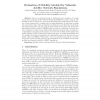Free Online Productivity Tools
i2Speak
i2Symbol
i2OCR
iTex2Img
iWeb2Print
iWeb2Shot
i2Type
iPdf2Split
iPdf2Merge
i2Bopomofo
i2Arabic
i2Style
i2Image
i2PDF
iLatex2Rtf
Sci2ools
99
Voted
ACMSE
2006
ACM
2006
ACM
Mobility models for vehicular ad hoc network simulations
: There is a growing interest in deployment and evaluation of routing protocols for Vehicular Ad-Hoc Wireless Networks (VANETs) in urban contexts. The mobility model of nodes is one of the most important factors that impacts the evaluation of any wireless ad-hoc routing protocol using simulations. In this paper we make the case that the state-of-the-art simulation techniques do not effectively model many important factors that come into play in urban mobile environment. We present two new simple mobility models for VANETs that account for constrained movement pattern of vehicles on urban streets. Using traffic patterns and street maps, we perform a comprehensive comparison of the impact of our two new mobility models against two earlier mobility models. Unlike prior results in this area, our results demonstrate that the mobility model used in simulation does significantly impact the delivery ratio and packet delays in VANETs. With plenty of room for further improvement, our models pr...
ACMSE 2006 | Mobility Model | Routing Protocol | Simple Mobility Models | Theoretical Computer Science |
Related Content
| Added | 13 Jun 2010 |
| Updated | 13 Jun 2010 |
| Type | Conference |
| Year | 2006 |
| Where | ACMSE |
| Authors | Niranjan Potnis, Atulya Mahajan |
Comments (0)

